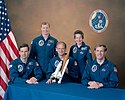STS-30
 | |
| Dane misji | |
| Indeks COSPAR | 1989-033A |
|---|---|
| Zaangażowani | |
| Oznaczenie kodowe | STS-30 |
| Pojazd | |
| Wahadłowiec | |
| Załoga | |
 Od lewej: Ronald J. Grabe, David M. Walker, Norman E. Thagard, Mary L. Cleave i Mark C. Lee. | |
| Dowódca | |
| Start | |
| Miejsce startu | |
| Początek misji | 4 maja 1989 |
| Orbita okołoziemska | |
| Apogeum | 366 km |
| Perygeum | 361 km |
| Okres orbitalny | 91,8 min |
| Inklinacja orbity | 28,9° |
| Lądowanie | |
| Miejsce lądowania | Edwards AFB, pas startowy 22 |
| Lądowanie | 8 maja 1989 |
| Czas trwania misji | 4 dni, 0 godz, 56 min, 28 sek |
| Przebyta odległość | 2 706 912 km |
| Liczba okrążeń Ziemi | 65 |
| Program lotów wahadłowców | |
STS-30 (ang. Space Transportation System) – czwarty lot amerykańskiego wahadłowca kosmicznego Atlantis i dwudziesta dziewiąta misja programu lotów wahadłowców. Głównym celem misji było wyniesienie na orbitę sondy kosmicznej Magellan przeznaczonej do badania planety Wenus. Odznaka misji przedstawia karawelę Magellana, tor lotu na Wenus i nazwiska astronautów[1].
Załoga
- David M. Walker (2)*, dowódca (CDR)
- Ronald Grabe (2), pilot (PLT)
- Norman Thagard (3), specjalista misji 1 (MS1)
- Mary Cleave (2), specjalista misji 2 (MS2)
- Mark C. Lee (1), specjalista misji 3 (MS3)
- *(liczba w nawiasie oznacza liczbę lotów odbytych przez każdego z astronautów)
Parametry misji
- Masa:
- startowa orbitera: 118 441 kg
- lądującego orbitera: 87 296 kg
- ładunku: 20 833 kg
- Perygeum: 361 km
- Apogeum: 366 km
- Inklinacja: 28,9°
- Okres orbitalny: 91,8 min
Cel misji
Wysłanie z pokładu wahadłowca międzyplanetarnej sondy Magellan, która udała się w kierunku Wenus, gdzie przez cztery lata wykonywała mapę powierzchni planety przy pomocy pokładowego radaru skanującego[1].

Zobacz też
Przypisy
Linki zewnętrzne
- podsumowanie misji STS-30 na stronie NASA (ang.)
- Mark Wade: STS-30 (ang.). W: Encyclopedia Astronautica [on-line]. [dostęp 2017-07-23].
- Spaceflight mission report: STS-30 (ang.). W: Spacefacts [on-line]. [dostęp 2017-07-23].
Media użyte na tej stronie
The flag of Navassa Island is simply the United States flag. It does not have a "local" flag or "unofficial" flag; it is an uninhabited island. The version with a profile view was based on Flags of the World and as a fictional design has no status warranting a place on any Wiki. It was made up by a random person with no connection to the island, it has never flown on the island, and it has never received any sort of recognition or validation by any authority. The person quoted on that page has no authority to bestow a flag, "unofficial" or otherwise, on the island.
Five astronauts composed the STS-30 crew. Pictured (left to right) are Ronald J. Grabe, pilot; David M. Walker, commander; and mission specialists Norman E. Thagard, Mary L. Cleave, and Mark C. Lee. The STS-30 mission launched aboard the Space Shuttle Atlantis on May 4, 1989 at 2:46:59pm (EDT). The primary payload was the Magellan/Venus Radar mapper spacecraft and attached Inertial Upper Stage (IUS).
Magellan being deployed with IUS stage during the STS 30 (Atlantis) flight.
The STS-30 patch depicts the joining of NASA's manned and unmanned space programs. The sun and inner planets of our solar system are shown with the curve connecting Earth and Venus symbolizing the shuttle orbit, the spacecraft trajectory toward Venus, and its subsequent orbit around our sister planet. A Spanish caravel similar to the ship on the official Magellan program logo commemorates the 16th century explorer's journey and his legacy of adventure and discovery. Seven stars on the patch honor the crew of Challenger. The five-star cluster in the shape of the constellation Cassiopeia represent the five STS-30 crewmembers - Astronauts David Walker, Ronald Grabe, Norman Thagard, Mary Cleave and Mark Lee - who collectively designed the patch.



